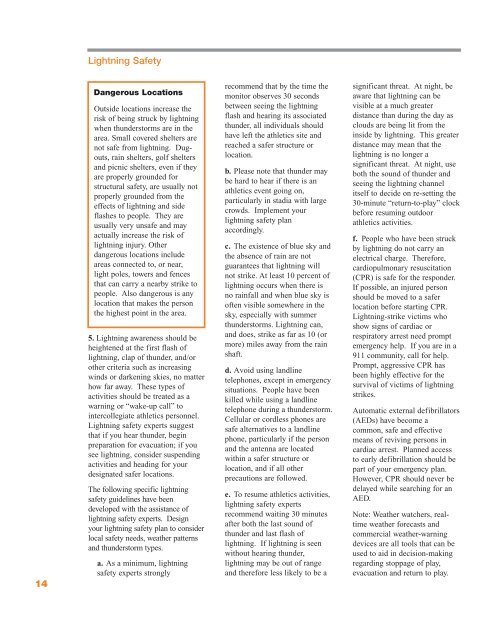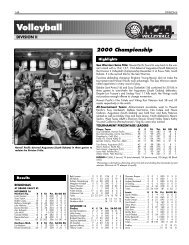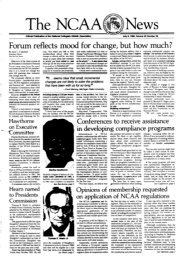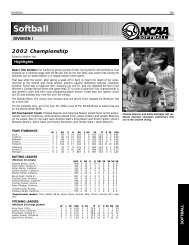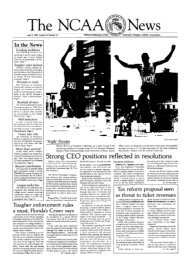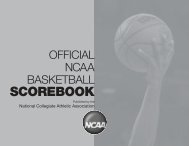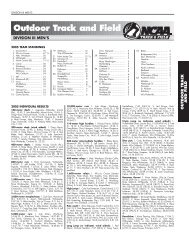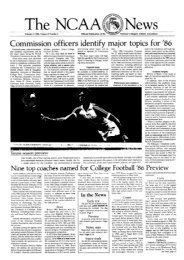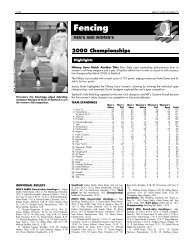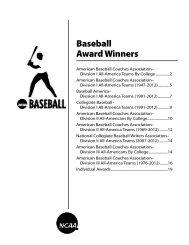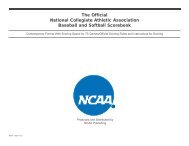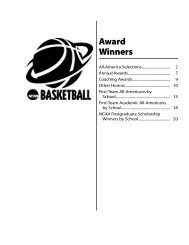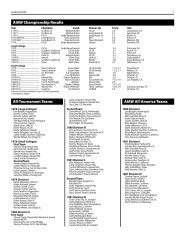Sports Medicine Handbook - NCAA
Sports Medicine Handbook - NCAA
Sports Medicine Handbook - NCAA
You also want an ePaper? Increase the reach of your titles
YUMPU automatically turns print PDFs into web optimized ePapers that Google loves.
14<br />
Lightning Safety<br />
Dangerous Locations<br />
Outside locations increase the<br />
risk of being struck by lightning<br />
when thunderstorms are in the<br />
area. Small covered shelters are<br />
not safe from lightning. Dugouts,<br />
rain shelters, golf shelters<br />
and picnic shelters, even if they<br />
are properly grounded for<br />
structural safety, are usually not<br />
properly grounded from the<br />
effects of lightning and side<br />
flashes to people. They are<br />
usually very unsafe and may<br />
actually increase the risk of<br />
lightning injury. Other<br />
dangerous locations include<br />
areas connected to, or near,<br />
light poles, towers and fences<br />
that can carry a nearby strike to<br />
people. Also dangerous is any<br />
location that makes the person<br />
the highest point in the area.<br />
5. Lightning awareness should be<br />
heightened at the first flash of<br />
lightning, clap of thunder, and/or<br />
other criteria such as increasing<br />
winds or darkening skies, no matter<br />
how far away. These types of<br />
activities should be treated as a<br />
warning or “wake-up call” to<br />
intercollegiate athletics personnel.<br />
Lightning safety experts suggest<br />
that if you hear thunder, begin<br />
preparation for evacuation; if you<br />
see lightning, consider suspending<br />
activities and heading for your<br />
designated safer locations.<br />
The following specific lightning<br />
safety guidelines have been<br />
developed with the assistance of<br />
lightning safety experts. Design<br />
your lightning safety plan to consider<br />
local safety needs, weather patterns<br />
and thunderstorm types.<br />
a. As a minimum, lightning<br />
safe ty experts strongly<br />
recommend that by the time the<br />
monitor observes 30 seconds<br />
be tween seeing the lightning<br />
flash and hearing its associated<br />
thunder, all individuals should<br />
have left the athletics site and<br />
reached a safer structure or<br />
location.<br />
b. Please note that thunder may<br />
be hard to hear if there is an<br />
athletics event going on,<br />
particularly in stadia with large<br />
crowds. Implement your<br />
lightning safety plan<br />
accordingly.<br />
c. The existence of blue sky and<br />
the absence of rain are not<br />
guarantees that lightning will<br />
not strike. At least 10 percent of<br />
lightning occurs when there is<br />
no rainfall and when blue sky is<br />
often visible somewhere in the<br />
sky, especially with summer<br />
thunderstorms. Lightning can,<br />
and does, strike as far as 10 (or<br />
more) miles away from the rain<br />
shaft.<br />
d. Avoid using landline<br />
telephones, except in emergency<br />
situations. People have been<br />
killed while using a landline<br />
telephone during a thunderstorm.<br />
Cellular or cordless phones are<br />
safe alternatives to a landline<br />
phone, particularly if the person<br />
and the antenna are located<br />
within a safer structure or<br />
location, and if all other<br />
precautions are followed.<br />
e. To resume athletics activities,<br />
lightning safety experts<br />
recommend waiting 30 minutes<br />
after both the last sound of<br />
thunder and last flash of<br />
lightning. If lightning is seen<br />
without hearing thunder,<br />
lightning may be out of range<br />
and therefore less likely to be a<br />
significant threat. At night, be<br />
aware that lightning can be<br />
visible at a much greater<br />
distance than during the day as<br />
clouds are being lit from the<br />
inside by lightning. This greater<br />
distance may mean that the<br />
lightning is no longer a<br />
significant threat. At night, use<br />
both the sound of thunder and<br />
seeing the lightning channel<br />
itself to decide on re-setting the<br />
30-minute “return-to-play” clock<br />
before resuming outdoor<br />
athletics activities.<br />
f. People who have been struck<br />
by lightning do not carry an<br />
electrical charge. Therefore,<br />
cardiopulmonary resuscitation<br />
(CPR) is safe for the responder.<br />
If possible, an injured person<br />
should be moved to a safer<br />
location before starting CPR.<br />
Lightning-strike victims who<br />
show signs of cardiac or<br />
respiratory arrest need prompt<br />
emergency help. If you are in a<br />
911 community, call for help.<br />
Prompt, aggressive CPR has<br />
been highly effective for the<br />
survival of victims of lightning<br />
strikes.<br />
Automatic external defibrillators<br />
(AEDs) have become a<br />
common, safe and effective<br />
means of reviving persons in<br />
cardiac arrest. Planned access<br />
to early defibrillation should be<br />
part of your emergency plan.<br />
However, CPR should never be<br />
delayed while searching for an<br />
AED.<br />
Note: Weather watchers, realtime<br />
weather forecasts and<br />
commercial weather-warning<br />
devices are all tools that can be<br />
used to aid in decision-making<br />
regarding stoppage of play,<br />
evacuation and return to play.


